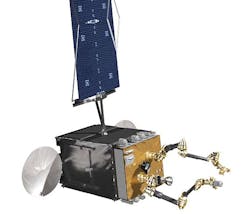DARPA kicks off RSGS program to build a space robot to maintain geosynchronous satellites
ARLINGTON, Va., 19 May 2016. U.S. military researchers are asking industry to develop a space robot to be based in geosynchronous Earth orbit (GEO) to repair, maintain, and upgrade satellites operating in this high-altitude and difficult-to-reach orbit.
Officials of the U.S. Defense Advanced Research Projects Agency (DARPA) in Arlington, Va., issued a solicitation Wednesday (DARPA-PS-16-01) for the Robotic Servicing of Geosynchronous Satellites (RSGS) program.
The RSGS seeks to create a dexterous robotic capability able to provide persistent robotic servicing capabilities in GEO -- the orbit 22,000 miles above the Earth's surface in which geostationary satellites operate.
The program will begin by creating a robotic servicer operated by a commercial company, and ultimately will establish an enduring, reliable, cost-effective GEO satellite servicing presence, DARPA officials say.
DARPA experts want a U.S. space industry team to build, own, and operate a robotic servicing vehicle in or near GEO. This space vehicle will integrate a government-provided payload, provide communications with the ground, and operate the vehicle commercially for many years.
Related: DARPA continues program to reuse parts from orbiting dead satellites
The idea is for the servicing robot owner to be able to make money by servicing commercial and government GEO satellites, DARPA officials say. Most damaged or disabled spacecraft operating in GEO are not recoverable or fixable, and often are left to drift uselessly in space.
Robotic GEO servicing capabilities should include inspecting functional spacecraft with anomalies; correcting mechanical problems like solar array and antenna malfunctions; moving satellites to different orbits; fixing malfunctioning propulsion systems; and upgrading satellites with new capabilities.
The target date to launch the robotic servicer on a government-furnished rocket to or near GEO for demonstration is spring 2021. This demonstration is to validate the robotic servicer's readiness for commercial use.
DARPA experts say they would like to choose the RSGS team by the end of January 2017. Companies interested should submit summaries to DARPA online at https://baa.darpa.mil/ no later than 5 July 2016. Full proposals will be due at a later time.
Email questions or concerns to DARPA at [email protected]. More information is online at https://www.fbo.gov/spg/ODA/DARPA/CMO/DARPA-PS-16-01/listing.html.

